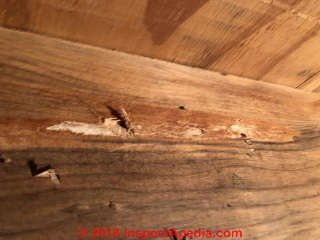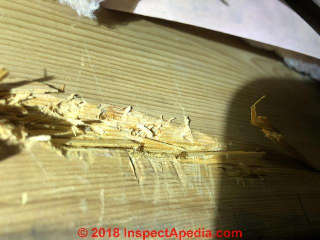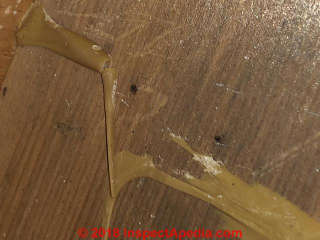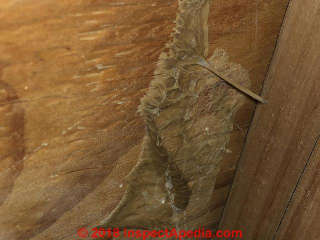 Mold Contamination Guide FAQs #3
Mold Contamination Guide FAQs #3
Recent Q&A on building mold contamination
- POST a QUESTION or COMMENT about how to find, test for, remove, clean up and prevent mold contamination in buildings
Frequently-asked Quest ins & Answers about indoor mold contamination:
Questions about how to identify and evaluate indoor mold contamination and what to do about it.
Page top: construction adhesive mistaken for toxic mold growth. More examples of this mistake are on this page.
This article series explains how to recognize mold, how to test for unsafe mold, how to clean up or remove mold, how to prevent mold contamination in buildings, and what mold related illnesses and symptoms have been reported are all discussed in depth.
InspectAPedia tolerates no conflicts of interest. We have no relationship with advertisers, products, or services discussed at this website.
FAQS: Find, Test, Inspect For, Remove, & Prevent Mold Contamination
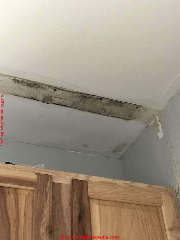 These questions & answers were posted originally at MOLD CONTAMINATION IN BUILDINGS - topic home. Please be sure to review the guidance gien there.
These questions & answers were posted originally at MOLD CONTAMINATION IN BUILDINGS - topic home. Please be sure to review the guidance gien there.
[Click to enlarge any image]
On 2018-11-27 by (mod) - mold behind ceiling trim ? Further investigation is needed to define extent of mold growth
Jak
it would be quite unusual for only a single General in species of mold to be growing in wet conditions indoors.
So any statement that is attempting to be definitive about exactly what mold genera species you have would be mistaken. And generally unnecessary as it won't change what's needed.
It's likely the indoor modes are at least allergenic and some can be more harmful.
In no case would you leave a mold Reservoir in a ceiling or wall or for cavity.
On 2018-11-27 by Jak
When we moved into our home in June 2018, we discovered a leak in the roof and immediately had a new roof put on.
After that, we started remodeling and found mold under the crown moulding in the kitchen. I’m sure it was leaking down the wall as well. I’m just wondering if this kind of mold is dangerous or if we can clean it ourselves.
On 2018-09-23 by AA
You have been a great help :)
Thank you.
On 2018-09-23 by (mod) - what the mold lab can and can't tell you
I commented on the validity and utility of air samples.
All the lab can say us whats in a sample, nothing else.
The lab and mold test don't tell us
- where is the mold reservoir
- how much demolition and cleaning are needed
- what do we need to fix to prevent mold growth from returning
On 2018-09-23 by Anonymous
Thank you for your quick reply. I completely understand your point about conflict of interest.
Should I still be concerned if the company only took the samples and sent it to a microbial Testing Lab? The report is from the lab.
Just to give you a brief background we had water come in through a small area in the ceiling two months back because the upstairs neighbors flooded their bathroom . A licensed plumber investigated and reported no leaks in plumbing. We immediately hired a cleaning company to remove moisture and clean any mold if present.
There has been no leaks since then the area is completely dry.
This test was done last week. I am concerned about Chaetomium showing up in the air test results.
Raw count 3 ; 20 Count/M3. And also in the surface swab test Chaetomium, Spore estimate: Moderate; Mycelial Estimate: Few; Spore count 640 /cm2. Are these levels so high that I should be concerned about health-wise. I would greatly appreciate your help. Thanks.
On 2018-09-22 by (mod) - mold tests by the mold cleanup company?
In my view there is an innate conflict of interest when a mold test and remediation plan are performed by the people who will be paid to do the work, and an even worse conflict if the same procedure is used to perform the follow-up clearance testing to prove that the job was successful.
Air testing as a building screen for mold is fundamentally unreliable, especially if results are low or negative, and even if it suggests a problem it is not diagnostic nor prescriptive: giving not a shred of a clue about where the problem is nor about what work is needed to correct it.
That's why an onsite inspection by an independent expert is what's called for.
Finally, when a company gets paid to perform a "test" and the customer has to go to a third party (who knows nothing about the building, history, materials, occupant vulnerabilities, etc.) to ask for an interpretation of the test, in my view the customer should get their money back as such work is unconscionable.
On 2018-09-22 by AA what do my mold test results mean? Air and swab tests
Hi,
Following is the report of Mold testing done by a remediation company. The swab test result was Chaetomium, Spore estimate: Moderate; Mycelial Estimate: Few; Spore count 640 /cm2.
They took two air samples One in the bathroom and other from outside.
Outside/Baseline
Alternaria raw count 1 ; 7 Count / M3.
Ascospores raw count 174 ; 1160Count / M3
Aspergillus Penicillium raw count 26 ; 173Count / M3.
Basidiospores raw count 286 ; 1907 Count / M3.
Chaetomium Raw count ND
Cladosporium raw count 19 ;127Count / M3
Curvularia ND
Myxomycetes raw count ND
pithomyces raw count 2 ; 13 Count / M3
Inside/Bathroom
Alternaria ND
Ascospores raw count 3; 20 Count / M3
Aspergillus Penicillium raw count 34 ; 227 Count / M3.
Basidiospores ND.
Chaetomium Raw count 3 ; 20 Count/M3
Cladosporium raw count 3 ;20 Count / M3
Curvularia Raw count 1; 7 Count/M3
Myxomycetes Raw count 1; 7 Count/M3
pithomyces ND
Following were not found in bathroom or outside air samples
Epicoccum
Fusarium
Stachybotrys
Stemphylium
Torula
Ulocladium
Unspecified Spore
Bipolaris|Drechslera
Can you help me evaluate these results. Is it a dangerous situation for health. The remediation cost is around 3000$ by the same company.
On 2018-09-08 by (mod) - air scrubbers are not effective at curing a mold contamination problem
You need to find and remove the mold Colony or contamination Source. Simply trying to clean the air is pointless.
The mold source or reservoir can and will simply release more mold into the building air - at a rate that varies by building conditions such as moisture level, temperature, and of course mold genera and species.
Once you have removed the mold source, you could if you like use an air scrubber but you would be just as well to Simply ventilate with fresh air.
On 2018-09-07 y KC
We've removed the a/c and plan to remove caulking/sink gasket and replace. However, I'm still concerned that spores have been blowing all over the main floor of our house. We have a relatively "dry" house and plaster walls so I'm not concerned with a sudden visible outbreak but the concentration of spores in our indoor air.
If air scrubbing is useless, would it be better to use a HEPA vac to remove the mold spores by vacuuming the floors/walls? Or how would you proceed? Thanks again.
On 2018-09-06 by (mod) - mold growth on plastic vents of split system AC air conditioner
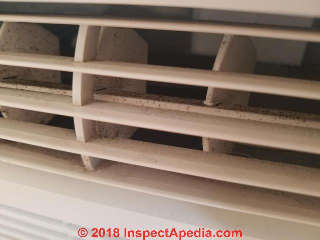 You want to find the mold, remove it, and make sure there are no remaining leaks that will cause it to recur.
You want to find the mold, remove it, and make sure there are no remaining leaks that will cause it to recur.
Scrubbing the air is as effective at removing mold sources as standing in the garage holding your vacuum cleaner wand in the air and hoping it will remove dust bunnies from under the couch in the living room.
See SPLIT SYSTEM AC MOLD CONTAMINATION REMOVAL for advice on what to do about the mold in your photo.
On 2018-09-06 by KC - mold on air conditioner
We moved into our home in 2010, included were two window air conditioners which were stored in the basement and we've used the past 8 summer seasons.
In the past year or so, I've noticed mold growth on caulking around the sink, on plastic/rubber parts of windows, and around our bathtub, a certain change but relatively "normal" places to see small areas of mold.
The alarm bell went off yesterday when I discovered mold contamination in our downstairs window air conditioner that we've used the past 8 years.
We taped it off and removed it but I'm obviously concerned as it has been at the very least actively blowing mold spores around our house on on our food (near our dining rm table) the past several weeks/months.
We don't see evidence of structural mold (walls are plaster) but I'm unsure of my next step.
We plan to removed caulking and replace, clean windows etc. but would it be worthwhile to identify the mold, or have the air professionally scrubbed? Advice?
On 2018-08-19 by (mod) - example of dark or black mold on a floor joist
AG
Your photo below shows a thin growth of black or dark mold on a floor joist.
It's possible that this is a cosmetic-only mold -
see BLACK MOLD, HARMLESS for details.
On 2018-08-18 by agbayaa
What about the dark stuff on this wood joist - in the photo above?
On 2018-08-19 by (mod) - example of mechanical damage to wood mistaken for mold contamination
AG
Your photo below shows mechanical damage to wood, not mold growth, probably something that happened during handlinbg such as damage by a fork lift while loading wood onto a truck.
On 2018-08-18 by agbayaa - strange stuff on wood - is this toxic mold?
Are these funny marks on my wood mold damage?
On 2018-08-19 by (mod) - examples of glue or construction adhesive mistaken for mold contamination
AG
The tan stuff in your photos (below) is construction adhesive, not a growth, followed by mechanical damage, looks like gouging from a fork-lift or something similar.
Here is another
Thanks. Here is another crazy growth. I wish I knew how to add a few pix at once to this comment.
On 2015-04-17 by (mod) -
Jordan Johnson said:
My parents had a pretty bad case of mold in their house. A pipe had burst and they thought that they had cleaned up the problem entirely. Unfortunately, the walls were too wet and they weren't properly taken care of at the time. From what they told me it seems like the removal process take a long time.
On 2014-10-22 by Maria Cantarero
This site was indispensable l8 months ago, when my husband and I decided to conquer a three room mold problem ourselves, after being 'taken' by a contractor. I just wanted to thank you and share a very unlikely source of mold I just discovered.
After running out of time, we had to spend the winter in one tiny room until spring returned, and we could put up drywall with the windows open. I have a severe allergy to several molds and multiple chemical sensitivities.
We put our sectional sofa in the corner of the room, but after a few weeks, I could not sit in that corner without having a sneezing fit. I thought it was the sofa -- we even wrapped the whole thing in plastic!! But nothing changed. We were mystified. I gave up and sat on the opposite side of the room in a lawn chair.
Fast forward to this summer. We emptied that room to have it painted and carpeted.
The contents is still in storage. Just last night, I was moving things around in the storage room when I came across several paintings that were leaning against the wall. One of them was an unframed oil painting, one of my favorites. It hung close to the corner, right above the corner sectional.
I was taken back by a familiar whiff of "mildew" [which I now know as mold], and I turned it over.
The top and inside edges had what looked and smelled like mold; I wasted no time trying to identify it's type, but I'm guessing aspergillus, because it was blackish-greenish, and that's what I've tested highest for, with an almost immediate reaction.
While this type of mold is not normally dangerous to healthy people, people with chronic diseases such as myself--disabling arthritis--and those with severe asthma can really be impacted.
I take this to be a sign of far too high humidity in this room that is adjacent to the kitchen, and we will probably have to install an exhaust fan. Thanks so much for the education, InspectApedia!
On 2014-08-29 by (mod) -
Sounds as if you are describing a type of puffball mushroom fungus.
On 2014-08-29 by Susan
Just moved laundry basket and golf ball size, gold mushroom looking thing growing on base of bathtub. I pierced it and very fine black soot spilled out. This was not there 2 weeks ago. Right on place where caulking pulled away from tub. Use tub a lot, bathroom always warm. I have been feeling bad (exhausted) for 2 weeks but ball was intact until now. I used Clorox towelettes and Lysol.
On 2014-08-28 by (mod) -
Jessica
Certainly mold spores, especially those tiny Penicillium / Aspergillus spores, are easily blown through a building by an HVAC system, moreso if return air is taken from the mold-contaminated area.
Just how serious that cross-contamination was, how much cleaning is needed (wiping, HEPA vacuuming) in the occupied space and in the HVAC system depends on the results of more expert inspection and possibly testing than we can know by e-texting on this question.
And yes it's so that no mold cleanup will be effective if we don't find and fix the cause of its growth in the first place -roof leaks or something else.
On 2014-08-27 by Jessica
Currently dealing with a mold problem that was discovered after my own investigation due to "sick" cats with perfect blood panels.
My two story house has a history of recurring basement floods (no more than a few inches of standing water), leaky plumbing from a toilet, a sink, and a bathtub (all in different rooms/floors of the house). All previous sources of water were not attended to immediately as they should have been.
Also, over the last few years there is a history of a mushroom or two popping up every once in a while out of the floor next to a bathtub on the first floor of the house (different looking each time).
There was also history of roof leaks but I was not here so I do not know how long that went on before being fixed.
Upon discovery of mold on the walls in the basement I had a mold surface test done that came back 51%-75% Asp/Pen group and 26%-50% Chaetomium. While cleaning the basement.. more mold was discovered on walls in our mechanical room along with most everything that was being stored in the room.
Further investigation revealed there were no filters in our HVAC machine that had been running all winter long.
Mold discovery and testing was done nearly 5 months ago and we are still working on getting it cleaned up that has been put off due to health and financial issues. Because there is not a giant wall saturated in mold (although there are numerous walls with mold spots in the basement)...
I am having a hard time getting others in the household to believe this is a serious issue that needs to be fully investigated.
My questions are... since the HVAC (in the moldiest room in the house) was running with no filters could this have been spreading mold spores throughout the house?
And is there room for concern that there is mold in the duct work? If visible mold is neither cleaned nor removed does it still pose a threat?
If so, is there a time frame that could go by at which point it is no longer a threat...? Say, a roof leak that was repaired 7 years ago? Need for more testing?
On 2014-08-14 by (mod) - can't identify a fungus or mold from just the e-text
Orange,
Sorry but we can't identify a fungus or mold from just the e-text in your note. It may not be mold but pine resin sap - or it could be a fungus. There are about 1.5 million mold species, many of which might produce an orange colour.
On 2014-08-12 by Orange mold
Hello.
We are building a new home and recently noticed in the very humid (87% humidity) basement that many of the 2x4 studs on the staircase, have an orange colored mold on them. I was not able to find anything about orange mold and wondered if you knew if it is dangerous.
It is on pine construction wood. We also noticed that on the stair risers and on the back of the drywall there was some little furry black mold. After getting a dehumidifier, the humidity has lowered to 51% and the mold growth has lessoned and comfort level in the basement is better.
Please advise if you know what that orange mold is and what your best thoughts are on how to deal with this. I could send a few pictures if that would be helpful. Thank you for the wealth of information on your site.
Matthias
On 2014-07-21 by (mod) -
Re-posting without dis-allowed link
7/21/14 Aquademica said
Excellent entry! It's always nice when you can not only be informed, but also entertained!
[Added comments from the company's website in Sweden]
Aquademica was founded in 2005 and is the Swedish market leader in the area of leak detection. We have the resources and the know-how to carry out large investigations both on a local and international basis.
Energy companies, counties, construction companies, housing cooperatives and building service companies are among the customers that utilize Aquademica’s comprehensive leak detection solutions.
Our consultants are proficient in detecting leaks in several areas such as district heating systems, water pipes and roofs, and detect the source of the leakage without damaging the surrounding material.
We are truly leak detection professionals and our consulting engineers investigate the source of the leakage regardless of what and where it leaks. Having information about the source of the leak offers our customers the information they need to take proper action and repair the leak.
Stockholm Pipers Väg 165 170 73 Solna Phone: 08-730 14 00
On 2014-03-17 by (mod) -
I can't say exactly what to do about a building I have not seen and know so little about. But some general guidelines are that you need to follow the water, investigating the most-suspect areas first. There is an innate conflict of interest asking the repair company to check on their own work or define the scope of work they're to be hired to do.
That may be ok for you anyway or you may want to at least consider hiring an independent inspector who knows about this topic to give an independent definition of work needed.
See https://inspectapedia.com/mold/Hidden_Mold.htm on how to find hidden mold
and see
https://inspectapedia.com/mold/Mold_in_Buildings.htm on finding mold in buildings
and finally see
https://inspectapedia.com/mold/Hidden_Mold_Ceiling_Wall.htm
about making test cuts to look for mold in walls or ceilings.
Keep us posted and use our CONTACT link if you like to send along photos that might allow further comment.
Small areas of mold, if that's all you've got, say less than 30 sqft of contiguous moldy material, are usually handled as a normal cleanup job without heroic efforts, For a small or DIY mold cleanup project see
- MOLD CLEANUP, DO IT YOURSELF
- MOLD CLEANUP - SAFETY WARNINGS.
- MOLD CLEANERS - WHAT TO USE
- MOLD CLEANUP with BLEACH
- MOLD CLEANUP - MISTAKES to AVOID
Larger areas of mold contamination, or if a larger area is discovered in cleaning the small one, do indeed merit professional cleaning. When a professional mold cleanup job seems to be needed, these articles will be helpful
- MOLD CLEANUP COMPANIES
- MOLD CLEANUP GUIDE- HOW TO GET RID OF MOLD
- MOLD CLEANUP - HEALTH RISKS
- MOLD CLEANUP - LIMITATIONS
- MOLD CLEARANCE INSPECTIONS
- MOLD CLEARANCE: FOLLOWUP STEPS
On 2014-03-17 by Anonymous
Thanks so much. Would you please tell me exactly what to ask the water restoration company to do- how many 3"X4" holes and where? Should I get a separate mold person to examine the samples (samples of both drywall and the back of the cabinets?) Or should I just have the bathroom cab removed?
What about the kitchen cab- the floor there was wet but the walls only wet from wicking up. the kitchen has granite counters so it would be very expensive to redo. And any advice about dealing with the insurance company? Thanks alot, Sami
On 2014-03-17 by (mod) -
Sami, in nearly 40 years of building investigation I have never once seen a water extraction of the sort you describe that assured against mold growth in the "water extracted cavities". That's not to claim it has never been successful, but I wouldn't assume that. So if there is a complaint that suspects hidden mold, the effective approach is to explore those cavities.
I use a borescope but *never* would rely on it alone. If it finds mold I believe it. If it does not find mold I don't trust it. A 3x4" test cut in most-suspect areas is more reliable.
On 2014-03-17 by SAMI
I dont have pictures but I do have a little more detailed information about what water restoration happened when.
Not sure how much of this is relevant so Ill tell you everything. The day after the flood from the broken pipe, the water restoration company started using their truck based water extractor. The day after that they got some electricity on, started a dehumidifier and blower in the hallway outside the bathroom (pipe broke in bathroom ceiling.)
Four days after the night of the flood, they made holes in the tow kicks of bathroom and kitchen cabinets and started ducting air into them. Also they blew air into the baseboard space in the wall in back of the kitchen counter.
A week later they pulled out all equipment so the asbestos abatement team could come in, which got delayed. The top 2’ of drywall above the bath cabinet and the bath ceiling were removed six days later and they got the OK to go back in and put equipment back five days after that (3 weeks after the flood). At that time, they saw that the bath cabinet (or the wall in back- not sure which) was still wet so they made a 1’ wide flood cut at the end of the wall in the bathroom that the cabinet is on.
Five days after this, all moisture readings were below the amount of concern and they removed all equipment, 27 days after the flood. I have talked to the water restoration company and am thinking of requesting they do a boroscope inspection in the back of the bathroom cabinet and maybe cut out a little piece or pieces to check it out.
Is this sufficient? The cabinet is about 8 feet long and has a tile counter so would be expensive to replace, BUT I sure don’t want any future problems.
The house doesn’t smell of mold but all my clothes, towels, linens did and had to be cleaned. Thanks so much for your advice!
On 2014-03-13 by (mod) -
Sorry to read about the leak and damage, Sami.
In my experience, if the wall behind cabinets was wet, often there is mold growth in the wall cavity as well as on the unfinished back surface of the cabinets. I understand it's more trouble, but given what you've already faced, it would be a shame to button everything up and then have to tear it apart again.
If it were my home and I thought water had gone in that wall I'd take down the cabinets, inspect their rear surface, clean and re-seal if needed, inspect the wall, and at a minimum, make some test cuts to explore the wall cavity- removing materials until I see a clear 24" or one stud bay clear of visible mold.
Send photos if you like and I can comment further;
Keep me posted on what you find.
On 2014-03-12 by Sami
I have a question. My home was damaged by a burst pipe in the ceiling which occured in the bathroom. The restoration company removed the ceiling and one wall and made some flood cuts in the house but not to the wall in back of the bathroom cabinet which goes the length of the room.
They did not remove the cabinets in bath or kitchen nor the walls surrounding the bathtub and the shower. Should they have done so? Im very nervous about water having gotten not only into the walls but the space between the cabinet and the wall and underneath the cabinets. Please give me your opinion as soon as possible. Thanks!
On 2013-02-18 by (mod) -
Karen,
It is quite common for us to find mold growth on furniture, especially on the un-finished under-sides of bureau drawers, dining room tables, chairs, etc. A good inspection to find the areas where mold needs to be cleaned up includes a visual screen of those items.
Hard surfaces can usually be successfully cleaned with little trouble and using ordinary household cleaners; to improve the resistance of those same surfaces to mold growth in the future, the FIRST order of business is to find and fix the leaks or moisture problems that supported the unwelcome mold contamination in the building.
An optional second step may be to use a clear sealant or even a fungicidal sealant (if you like) on those same hidden mold-friendly surfaces.
If you've done a lot of cleaning and seem to keep getting high mold levels in the building then either the cleaning procedure was not quite correct or you haven't found and fixed the root cause of the trouble.
Your ending remark about HOW TO KILL mold is not the proper approach. The right approach is to REMOVE the mold contamination and FIX the causes for its growth. Killing is beside the point and risks leaving harmful particles in place or causing other damage.
On 2013-01-22 by KAREN MAXWELL
I have been desperate to I.D. what has caused the outbreak of mold / fungi in my new century home, especially all antique furniture. After just one year in our last home, we demolished an entire basement to black mold. HOWEVER, I did NOT realize ALL items were affected: furniture and even the underside of my ironing board.
My nick name is Felix the obsessed cleaner, so how was this possible! Who examines underneath furiture or ironing boards! I arrived in my new home and I and cat became ill. ALL houseplants died of a strange fungi per horticulturalist. I arranged an air test immediately but inspector said within safe limits.
However, the wrong test was done. You see, we have very high celings, fully open concept and use a lot of fresheners, consequential to trusted results IN THIS CASE. I continued finding, under a magnifier; transparent 'alive and moving' filaments hanging on undersides of tables, on plants and even in air. I then also realized it was not just extremely dark stain on antiques - it was black and brown MOLD and it was filamenting too!
Continuing examination of every inch of house with a magnifying glass, flashlight and camera, 2 yrs later and VERY ill, I re-hired the same insepctor.
This time, I did NOT want an air quality test. This time, I asked for very specific surface tests of furniture and 2 basement beams near intake vent as the worst affected furniture sat over it the whole time. TESTS ARE BACK. Although I did not want to be; I WAS RIGHT and am very frightened. Meanwhile, white dots and splotches have bloomed all over, and I don't know why exactly.
TEST RESULTS SHOW There are 3 types of mold: Aspergillus, Cladosporium, Penicillium as well as the filamenting in a big way. I discovered the extensive filamenting is related to Aspergillus. MUCOR is a filementous fungi that can be VERY dangerous and I have it here. It can and does enter a human host as a parasite through skin or inhalation. PLEASE - OH PLEASE - IF ANYONE HAS MORE INFO ON HOW TO KILL / CONTROL, PLEASE HELP.
Details about common mold test report "mold levels" and test accuracy and precision
- ACCURACY OF AIR TESTS for MOLD
- ACCURACY vs PRECISION of MEASUREMENTS
- MOLD LEVEL IN AIR, VALIDITY
- MOLD LEVELS IN BUILDINGS
- MOLD LEVEL REPORTS
Watch out: while it is possible to give valid general advice, nobody can make a confident, safe statement about just what mold remediation actions are needed from an email alone nor can a simple mold test in air or on surfaces define the extent of mold contamination nor cleanup that may be needed at a building.
...
Continue reading at MOLD CONTAMINATION IN BUILDINGS - topic home, or select a topic from the closely-related articles below, or see the complete ARTICLE INDEX.
Or see MOLD CONTAMINATION in BUILDINGS, FAQs-4 - more recent Q&A about dealing with building mold remediation
Or see these
Recommended Articles
- ACCEPTABLE MOLD LEVEL
- MOLD CONTAMINATION IN BUILDINGS - home - CONTENTS: building mold contamination guide: How to Find, Test, Inspect For, Remove, & Prevent Indoor Mold Contamination what to do about harmful indoor mold.
- SIX BASIC APPROACHES for Cleaning Up Indoor Air
- DETAILED ADVICEArticles on How to Find, Test, Clean up, Remove, & Prevent Indoor Mold Contamination
- DO YOU NEED TO HIRE AN EXPERT, bring in a mold remediator, hire a handyman, or clean up for yourself?
- MOLD RELATED ILLNESS - Asthma, Allergies, Lung, Neurological, IAQ Complaints?
- HOW TO PREVENT MOLD GROWTH & Avoid Mold Problems in Buildings
- MOLD CONTAMINATION DETECTION & Mold Identification Photos & Tips
- MOLD TEST PROCEDURES, valid and in-valid mold testing methods & protocols. Are some mold test kits junk science?
- MOLD DOCTORS - ENVIRONMENTAL MEDICINE
- MOLD / ENVIRONMENTAL EXPERT, HIRE ?
Suggested citation for this web page
MOLD CONTAMINATION in BUILDINGS, FAQs-3 at InspectApedia.com - online encyclopedia of building & environmental inspection, testing, diagnosis, repair, & problem prevention advice.
Or see this
INDEX to RELATED ARTICLES: ARTICLE INDEX to MOLD CONTAMINATION & REMEDIATION
Or use the SEARCH BOX found below to Ask a Question or Search InspectApedia
Ask a Question or Search InspectApedia
Try the search box just below, or if you prefer, post a question or comment in the Comments box below and we will respond promptly.
Search the InspectApedia website
Note: appearance of your Comment below may be delayed: if your comment contains an image, photograph, web link, or text that looks to the software as if it might be a web link, your posting will appear after it has been approved by a moderator. Apologies for the delay.
Only one image can be added per comment but you can post as many comments, and therefore images, as you like.
You will not receive a notification when a response to your question has been posted.
Please bookmark this page to make it easy for you to check back for our response.
Our Comment Box is provided by Countable Web Productions countable.ca
Citations & References
In addition to any citations in the article above, a full list is available on request.
- In addition to citations & references found in this article, see the research citations given at the end of the related articles found at our suggested
CONTINUE READING or RECOMMENDED ARTICLES.
- Carson, Dunlop & Associates Ltd., 120 Carlton Street Suite 407, Toronto ON M5A 4K2. Tel: (416) 964-9415 1-800-268-7070 Email: info@carsondunlop.com. Alan Carson is a past president of ASHI, the American Society of Home Inspectors.
Thanks to Alan Carson and Bob Dunlop, for permission for InspectAPedia to use text excerpts from The HOME REFERENCE BOOK - the Encyclopedia of Homes and to use illustrations from The ILLUSTRATED HOME .
Carson Dunlop Associates provides extensive home inspection education and report writing material. In gratitude we provide links to tsome Carson Dunlop Associates products and services.


